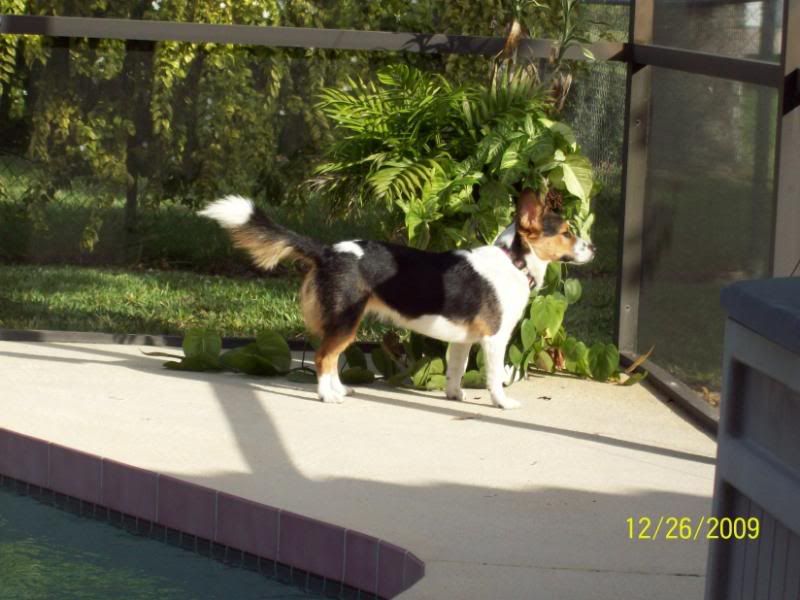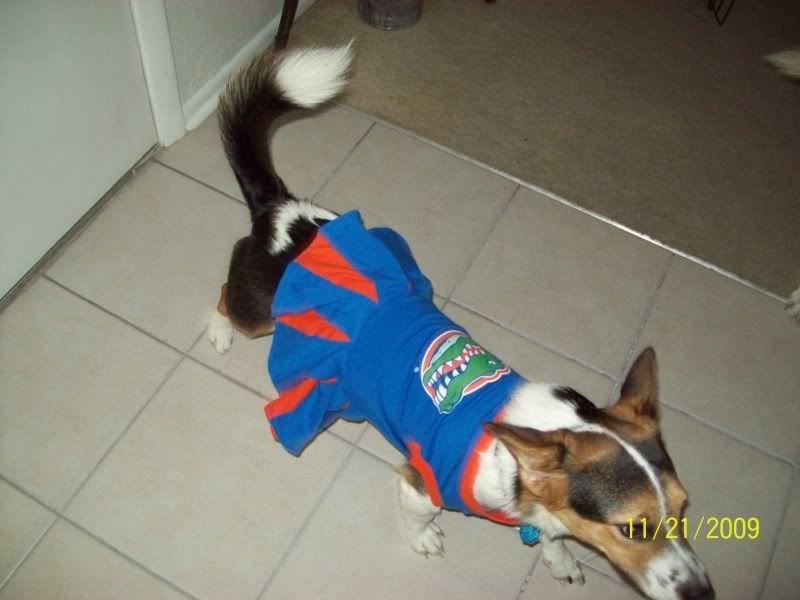So, I know the US doesn't have any standard for undocked dogs. The UK and AUS have the statement, "Set in line with topline. Natural carriage above topline when moving or alert."
The Cardigan standard is a little more in-depth in the UK and AUS, and much more in-depth for the US which states, "set fairly low on body line and reaching well below hock. Carried low when standing or moving slowly, streaming out parallel to ground when at a dead run, lifted when excited, but never curled over the back. High tail set is a serious fault."
Does anybody know if non-English language standards that do not allow tail docking (such as Finnish or Swedish) list what the Pembroke tail is supposed to be shaped like--something similar to the Cardigan US standard? I am just curious, because from these three standards, is an undocked Pem supposed to have a curled tail, a straight tail, or nine tails stemming from one base?
Or, if you don't know the standards, what kind of tail do you see undocked Pems as having, how long is it, etc?
Tags:
Replies to This Discussion
-
Permalink Reply by Jane Christensen on July 28, 2011 at 4:39pm
-
Permalink Reply by Rachael & Waffle on July 28, 2011 at 9:59pm
-
Ahh, that tail is so cute! I have not seen many pictures of tailed Pems with the tail very visible, but I have admittedly not paid very much attention. For some reason, I always imagined they were stupidly large. Do you have any older pictures of your puppies for, uh, research? haha
-
Permalink Reply by Anna Morelli on July 28, 2011 at 11:08pm
-
Lovely ! Sage looks so nice in this happy photo.
-
Permalink Reply by Jane on July 28, 2011 at 9:08pm
-
A pem tail can range from a natural bob to a full length tail. Usually they carry it over their back like a spitz type dog. It's a much higher tailset than a cardigan.
There are some good pictures of different lengths here: http://www.welshcorgi-news.ch/English.html
(edit, the link apparently only takes you to the main page. scroll down to the article on bobtail breeding)
I think I found a standard in swedish, I had to google translate it obviously but this is what it gave me, not much info on tails. I don't think there is much in the way of a strict standard as they can carry the natural bob tail gene and since tail docking is illegal in some countries it wouldn't make sense to penalize it.
Welsh corgi pembroke be a strong and robust
built. The body is medium, not short. It shall
give the impression of mass and strength in a compact design.
The relationship between muzzle and skull is 3:5.
The breed must be strong and provide a working serviceable impression. It
must be alert, active, forward and friendly, never nervous or
aggressive.
The head should be foxy in shape and overall.
Skull rather broad. It is flat between the ears.
Moderately marked.
Nose: Black.
Muzzle slightly tapering.
Jaws strong with perfect, complete and regular
scissor bite.
Eyes: Well set, round and medium-sized. It
brown color is of the coat. The expression is
be alert and intelligent.
Ears erect, medium sized and somewhat rounded.
An imaginary line drawn from tip of nose through eye should pass
through or near the ear tip.The neck should be fairly long.
The body is medium, not short. Viewed from above, the
slightly tapered.
Topline level.
Chest broad and deep and well let down between
front legs. Ribs well sprung.
Short, preferably natural. Naturally carried tail over back in motion
or arousal.
Tail docking is forbidden in Sweden
Shoulder blade well laid back at an angle of about 90
degrees to the upper arm.
Upper arm adapted around the chest.
Elbows: Close fitting to the sides, neither loose
or pinched.
Forearm short and as straight as possible. Bone
must be strong all the way down in his paws.
FEET: Oval with strong, well arched and tight toes.
The two middle toes are slightly longer than the outer. Pads
must be strong and well arched. Nails short.
Hindquarters should be strong and smooth. Hind legs should be short.
Strong bones right down to the feet.
Stifles well bent.
Hocks straight when viewed from behind.
Feet: Oval with strong, well arched and tight toes.
The two middle toes are slightly longer than the outer. Pads
must be strong and well arched. Nails short.Movement should be free and energetic, neither loose nor tied.
The forelegs have good reach without too much lift and
coordinate with thrusting action of hindlegs.
The coat is medium length, straight with dense undercoat, never soft;
wavy or wiry.
Solid color red, sable, fawn or black and tan, with or
without white markings on legs, chest and neck. Some white on head
and the nose is permissible.
approximately 25-30 cm
Males: 10-12 kg
Females: 9-11 kg
Any deviation from the standard is wrong and must be assessed in relation
to its degree and its effect on the dog
Health and well-being and ability to perform its traditional
work.
• Aggressive or overly shy.
• dog clearly showing physical or behavioral abnormalities
shall be disqualified.
Male animals should have two apparently normal testicles fully developed and
normally descended into the scrotum.
-
Permalink Reply by Rachael & Waffle on July 28, 2011 at 10:20pm
-
It's a little disappointing to see that the standard doesn't go into the details of the tail in a country where docking is banned. I have seen straight pem tails and curled Pem tails and really curled Pem tails and was hoping to find if one was more "correct". I suppose that is not the case. Thanks for finding and translating it for me! And those pictures too.
-
Permalink Reply by Jane on July 28, 2011 at 11:28pm
-
I did find this as well regarding judging. It's mostly opinion but shows that there really isn't a certain standard for the tail. I do think judges look at the tailset itself but the length or curl doesn't seem to be very important.
http://nationaldog.com.au/2011/january/national-dog-january-2011-fu...
A percentage of those who accept tails “prefer” them to be low set and held down like a cardigan corgi. But, as a judge, you cannot decide to ‘prefer’ something that is contrary to the Standard in any breed! The Standard for the tail is: Short, preferably natural. Docked: Short. Undocked: Set in line with topline. Natural carriage above topline when moving or alert. Pembrokes have Spitz heritage, and therefore a croup set fairly flat to the spine and a higher tail set than Cardigans with their teckel (ie Dachshund type) roots, and longer sloping croups. Most Pembrokes will stand and show in the breed ring with their tails dropped down behind them, but will raise it above the level of the topline, as required by the Standard, when they gait.
-
Permalink Reply by Rachael & Waffle on July 30, 2011 at 12:00am
-
Hmm, very interesting! Thanks again for finding what I could not! I find it kind of funny that the shape of the tail is not very important to breed type. Then again, I guess they've been without tails for so long that any tail is kind of not part of breed type!
-
Permalink Reply by Bob and SparkPlug on July 28, 2011 at 9:58pm
-
Permalink Reply by Rachael & Waffle on July 28, 2011 at 10:21pm
-
Was her tail shaved at the base? If you had to venture a guess, how long would you say that tail was and did it curl?
-
Permalink Reply by Bob and SparkPlug on July 28, 2011 at 11:21pm
-
No, not shaved. That's the way it is. How long? I don't know, maybe 12 inches. I don't remember it curling at all. I'll look through more pictures.
-
Permalink Reply by Bob and SparkPlug on July 28, 2011 at 11:23pm
-
Permalink Reply by Rachael & Waffle on July 30, 2011 at 12:02am
-
Go Gators! It's strange that the bottom of the tail doesn't have that brush. I think a slightly curling tail makes the dog look happier than a straight tail.
Rescue Store
FDA Recall
Canadian Food Inspection Agency Recall
Groups
© 2025 Created by Sam Tsang.
Powered by
![]()



